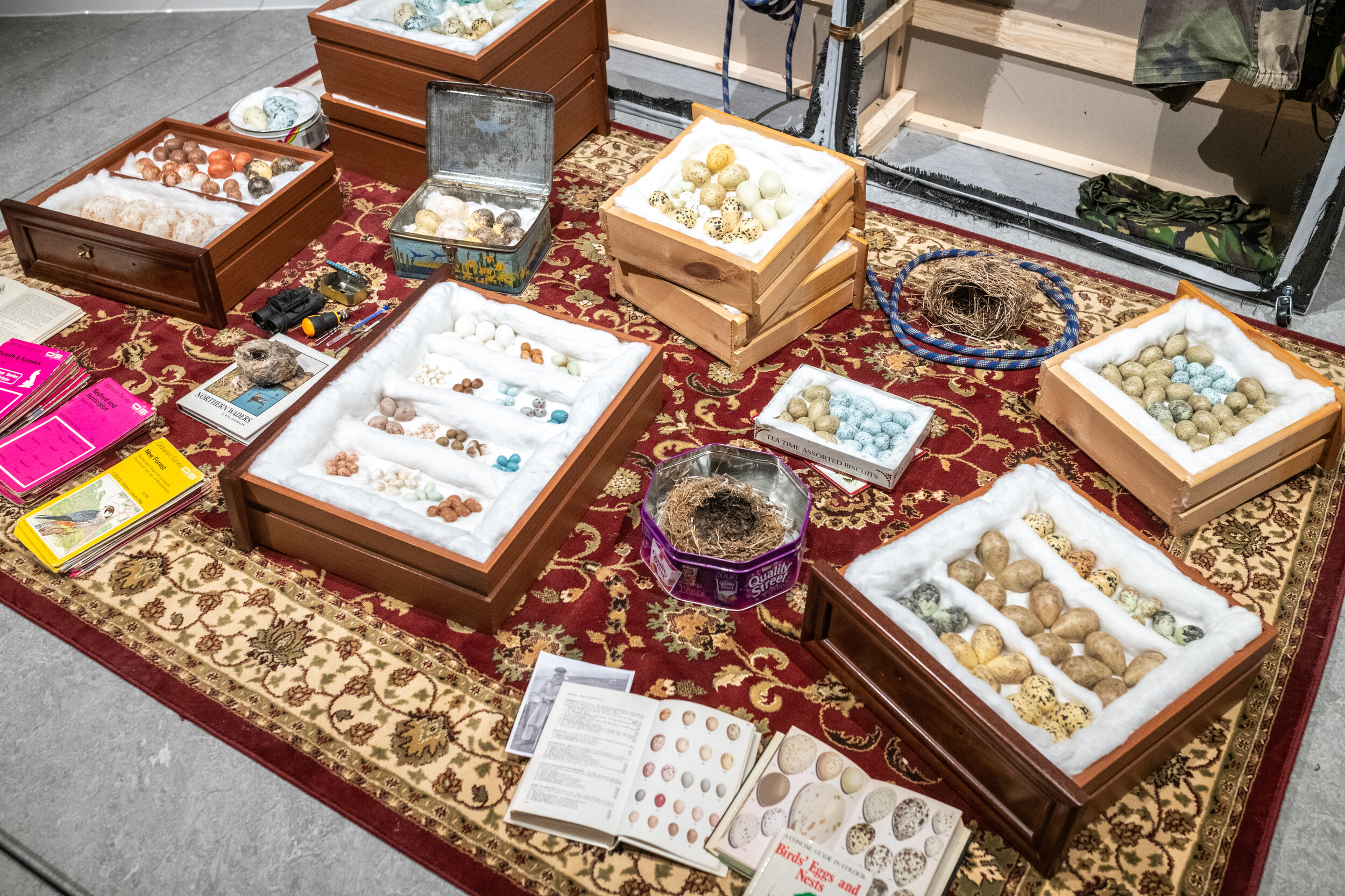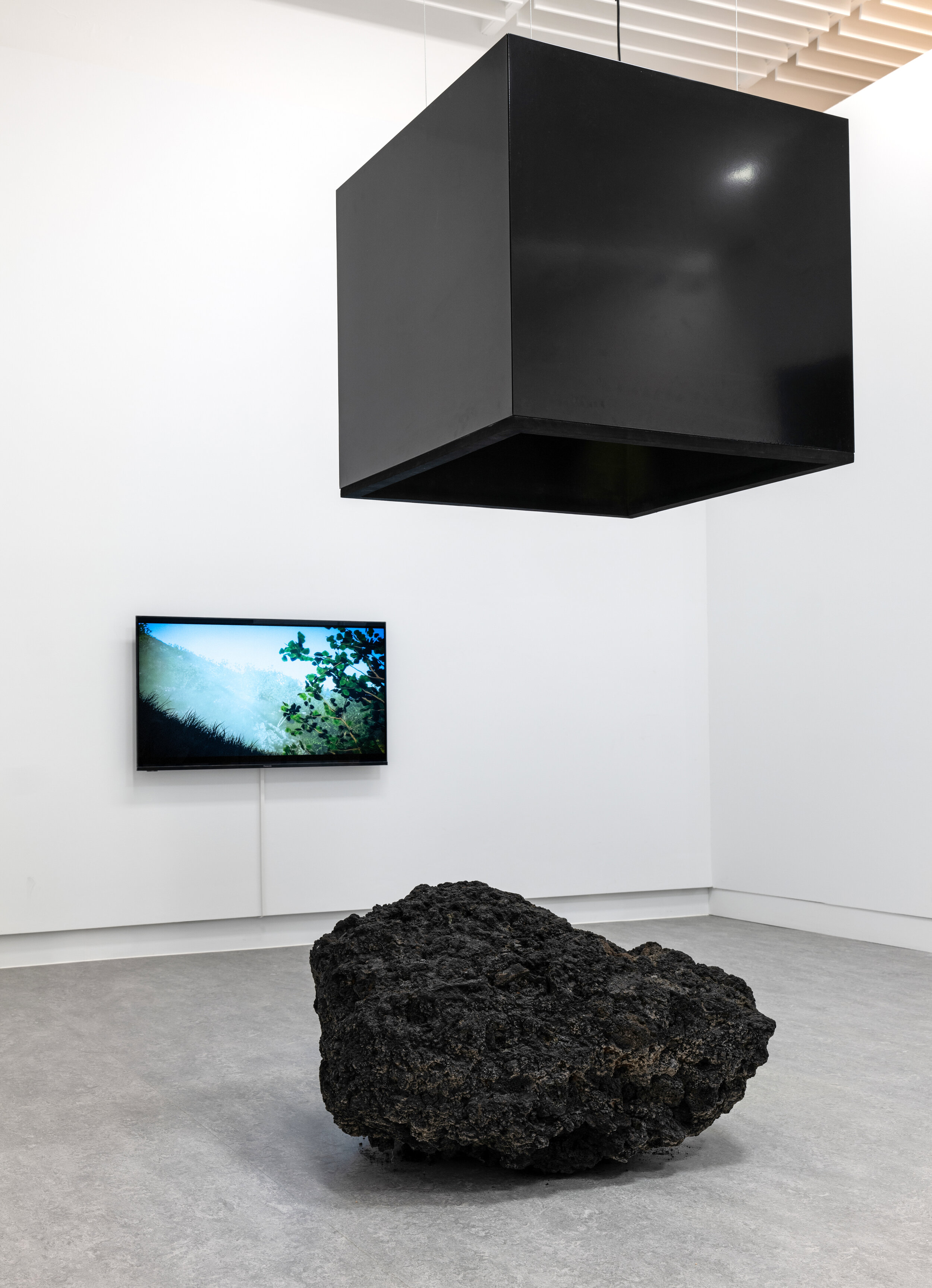
UnNatural History
Herbert Art Gallery & Museum
28 May - 22 August 2021
In UnNatural History artists and naturalists from across the globe explore the role of the artist as an intrinsic part of the science of natural history - enabling our modern understanding of ecology, climate change, extinction, and threats to biodiversity.
A tour of UnNatural History - led by Artistic Director of Invisible Dust, Alice Sharp - can be watched below.
The observational skills and techniques of artists, including their speculations, have enabled the development of the biological sciences since their inception. We learnt about plants and animals through drawings long before the advancements of technologies such as microscopes and photography.
UnNatural History features over 20 international artists working in Aotearoa New Zealand, Austria, Belgium, Germany, India, Ireland, Kenya, Mexico, Singapore, Turkey, UK and USA. It includes four newly commissioned works responding to the Herbert Art Gallery & Museum’s own natural sciences collection by Frances Disley, Dubmorphology, Tania Kovats and Gözde Ilkin.
Artists in the show include:
Christina Agapakis, Alexandra Daisy Ginsberg & Sissel Tolaas / Doug Aitken / Angela Brazil / Gerard Byrne / David Claerbout / Mat Collishaw / Dorothy Cross / Frances Disley / Dubmorphology / Alex Hartley / Andy Holden / Gözde İlkin / Tania Kovats / Michael Landy / Wangechi Mutu / Marianne North / Calvin Pang & David Robinson / Raqs Media Collective / Lisa Reihana / Sonya Schönberger / Yinka Shonibare CBE / Sarah Sze / Francis Upritchard / Danh Võ
UnNatural History connects these valuable natural history collections to the past, present and future of our relationship with nature through contemporary artists’ work in sculpture, installation, printmaking, photography, digital media and new technologies alongside historic paintings and drawings.
The visitor’s journey through the four galleries reflects this and starts with the past, through to the present and ends with the future of our relationship with natural history.

“The world's natural history collections have an important role to play by providing a rich record of how nature is changing. If we are to contain the threats that climate change and biodiversity loss bring, we need the knowledge and understanding that emerges from scientific discovery.”
— Natural History Museum, 2020
The Herbert Art Gallery & Museum’s natural history collection of 180,000 objects and specimens and has inspired this exhibition. It also has an important environmental role for local people. Many people in cities do not easily have the opportunity to see wild animals or unspoiled landscapes first hand - natural history provides that connection. Evidence shows that coming into contact with nature and natural history inspires us to want to protect both.

Tania Kovats, 'Crow', 2021. Courtesy of the artist and Parafin Gallery, London.

Mat Collishaw, 'The Machine Zone', 2019. Courtesy of the artist.

Michael Landy, 'Pineapple Weed', 2003. Private collection, London.

Francis Upritchard, various works. Courtesy of the artist and Kate Macgarry, London.

Alex Hartley, 'The Present Order', 2016. Courtesy the artist and Victoria Miro, London/Venice.

Marianne North, various works. Collection of the Royal Botanic Gardens, Kew.

Danh Võ, '2.2.1861', 2009. Private collection, London. 'Aconitum souliei, Inflorescence portion / Lilium souliei, outer and inner tepel / Anemone coelestina var. souliei, flowering plant / Rosa soulieana, fruit / Aconitum souliei, cauline leaf / Anemone coelestina, basal leaf / Anemone coelestina, carpel / Luzula rufescens, flowering plant / Anconitum souliei, upper cauline leaf / Anemone coelestina, basal leaf / Anemone coelestina, flowering plant / Rosa soulieana, fruiting branch / Lilium souliei, distal portion of flowering plant / Nepeta souliei, flowering plant / Rosa soulieana, flowering branch / Cerasus fruticosa, fruiting branch / Cerasus tomentosa var. souliei, fruiting branch', 2009. Courtesy of the artist and Marian Goodman Gallery, New York/Paris.

Andy Holden, 'The Oologists Record', 2017/21. Courtesy of the artist.

Sarah Sze, 'Magenta Stone', 2013-2015. Courtesy of the artist and Victoria Miro, London/Venice.

Yinka Shonibare CBE, 'Butterfly Kid (Boy) IV', 2019. Courtesy of the artist and Stephen Friedman Gallery, London.

Dorothy Cross, 'Foxglove 4', 2013. Private collection, courtesy of Frith Street Gallery, London.

Calvin Pang in collaboration with David Robinson, 'Where Am I', 2017/2021. Courtesy of the artists.

John Gerrard, 'SmokeTree II (Ash)', 2006. Courtesy of the artist; Thomas Dane Gallery, London/Naples and Pace Gallery, New York/London/Hong Kong/Palo Alto/Geneva/Seoul/East Hampton/Palm Beach.

Christina Agapakis, Alexandra Daisy Ginsberg and Sissel Tolaas, with support from Ginkgo Bioworks and IFF Inc, 'Resurrecting the Sublime: Hibiscadelphus Wilderianus Rock', 2019. Courtesy of the artists.
The Covid-19 pandemic has led to a re-evaluation of our connection to nature and relationship to climate change. We have spent more time in our gardens and green spaces, bringing greater awareness of the importance of our role as custodians. Urgent action is required to stop mass extinction and this exhibition seeks to inspire people to make changes to achieve this.

UnNatural History is a launch exhibition for the visual arts programme for Coventry City of Culture 2021. It brings a timely opportunity to explore our interconnectedness with nature through the unique lens of artists.
Tania Kovats
In her new works created for this exhibition in response to the Herbert’s Natural Sciences collection, Tania Kovats’ taxidermied roadkill animals invite us to consider our cultural attitudes and responses to death and extinction.
Taxidermy has historically been used in natural history collections to preserve and present animals and birds that often come from other parts of the world and are seen as rare or exotic.
The animals are usually portrayed in a lifelike state for the purpose of study or triumphant celebration. By contrast, Kovats has preserved animals that are common in Britain, and they have been stuffed in the positions in which they were found by the side of the road.
The display case includes school shoes worn by the artist’s son between the ages of eight and eighteen, emphasising the passage of time. Displayed as a series they recall a collection of butterfly specimens.
Tania Kovats, Badger, 2021. Courtesy of the artist and Parafin Gallery, London.
In a companion film work Kovats investigates the notion of a personal natural history collection, featuring items from her own collection that have taken on a new resonance during a lockdown winter under the shadow of Covid-19.
Tania Kovats in collaboration with Benjamin Wigley, hiber nation 20/21, 2020-21. Digital film. Courtesy of the artists and Parafin Gallery, London.
Tania Kovats, The space between 8 and 18, 2021. Courtesy of the artist and Parafin Gallery, London.
Tania Kovats, The space between 8 and 18, 2021. Courtesy of the artist and Parafin Gallery, London.
Tania Kovats, Crow, 2021. Courtesy of the artist and Parafin Gallery, London. Courtesy of the artist and Parafin Gallery, London.
Frances Disley
Frances Disley’s sculptures and film-works are a response to her local municipal park, which has offered sanctuary and inspiration to test ideas around the psychological benefits of being around plants, and in particular plants with medicinal properties that are common in urban landscapes.
Plant life and seasonality seem to offer a level of certainty and comfort in shifting chaotic times, during which healing gifts have been prepared and conversations shared with others, allowing Disley to think about being part of a community which incorporates people, plants and place.
Frances Disley, Getting to know you, 2021. Courtesy of the artist.
Frances Disley, Love letter to the mystery (Wavertree Park), 2021. Courtesy of the artist.
Angela Brazil’s works, selected for display by artist Frances Disley, are from the extensive holdings of her drawings, books, objects and ephemera in the Herbert’s own collection and Coventry Archives.
Gözde İlkin
For her newly commissioned work, Gözde İlkin places rocks and minerals from the Herbert’s collection into and alongside handmade stuffed sculptures. Made with found fabrics and painted and embroidered by the artist, the sculptures are inspired by the environmental importance of minerals and rocks to improve soil damaged by climate change. Rocks and minerals also have broader medicinal properties, and play a role in ritual and folklore. İlkin became interested in the subject after being intrigued by the rocks she encountered in walks around her neighbourhood in Istanbul.
Gözde İlkin, The Mouth of the Ground, 2021. Video. Courtesy of the artist and artSümer, Istanbul.
Gözde İlkin, The Mouth of the Ground, 2021. Courtesy of the artist and artSümer, Istanbul.
Dubmorphology
This newly commissioned work is the observation lab of time-travelling researchers from the future comprehending an imminent environmental disaster.
They travel back to our current age and beyond to investigate the impact of anthropogenic activities and behaviour through natural history collections, specifically the cultural entomology of the colonies of ants and bees.
The artists explore how environmental destruction has led to a barren, bleak and sterile uninhabitable planet where advanced technologies and an omnipresent force are used to control what is left of society, and individuals struggle for survival in the void.
Dubmorphology, Untitled, 2021. Courtesy of the artists.
Dubmorphology, Colony, 2021. Courtesy of the artists.
Echoes of Disruption is video entry 11543.1 from the laboratory log-book of time- travelling researchers, with journal notes narrated by an Artificial Intelligence programme. Having travelled back to the 21st century, researchers begin decrypting clues by exploring natural history collections, carrying out observational experiments and assembling interviews and content from scientific researchers, social scientists, cultural theorists, writers and poets. Their objective is to gain an insight into the turning point after which a dramatic change in the Earth’s delicate and precarious ecosystem leads to a catastrophic fracture in the future timeline.
Dubmorphology, Echoes of Disruption, 2021. Courtesy of the artists.
Dubmorphology, Untitled, 2021. Courtesy of the artists.
Explore the artist's process of creating their commissions:

We’re delighted to receive a 4 star review from Rachel Campbell-Johnson in The Times, who deemed it:
“a fascinating consideration of art’s relationship with the environment”
The show also received a review in CulturAll magazine;
“How often do you see wild animals first-hand? How often do you lose yourself in nature? Will opportunities to do either of these become fewer and fewer in our lifetimes? There’s a beautiful exhibition on at the Herbert Art Gallery and Museum in Coventry and it’s worth seeing. UnNatural History is a major exhibition focusing on natural history and climate change that looks at environmental urgency through a quizzical, revelatory and unusual lens. It damns, but it contains hope.”
“The installations are both startling and humbling…It’s easy to go away from the exhibition with a renewed sense of love of nature and a desire to do things differently, whatever your role in the world: so many people passionate about telling stories that need to be told, looking to the past to better the future. Not many art exhibitions have a similar offering”

For a more in-depth exploration of UnNatural History, please visit the gallery spaces through Matterport:
This has been captured on a phone, please forgive any scanning glitches.
Drone Flythrough
Experience the exhibition like never before!
The drone has been operated by Firefly AI.
#UnNaturalHistory21
Read the exhibition guide.
Curated by Adelaide Bannerman, Alice Sharp and Rachel Taylor, Invisible Dust and original concept developed with Deborah Smith.
Invisibledust.com
@Invisible_Dust
UnNatural History has been publicly funded by Coventry City Council, the Wellcome Trust and National Lottery funded by Arts Council England.
The digital exhibition has been curated by Joy Corcec.
Installation images by Garry Jones & Jaron James.






















